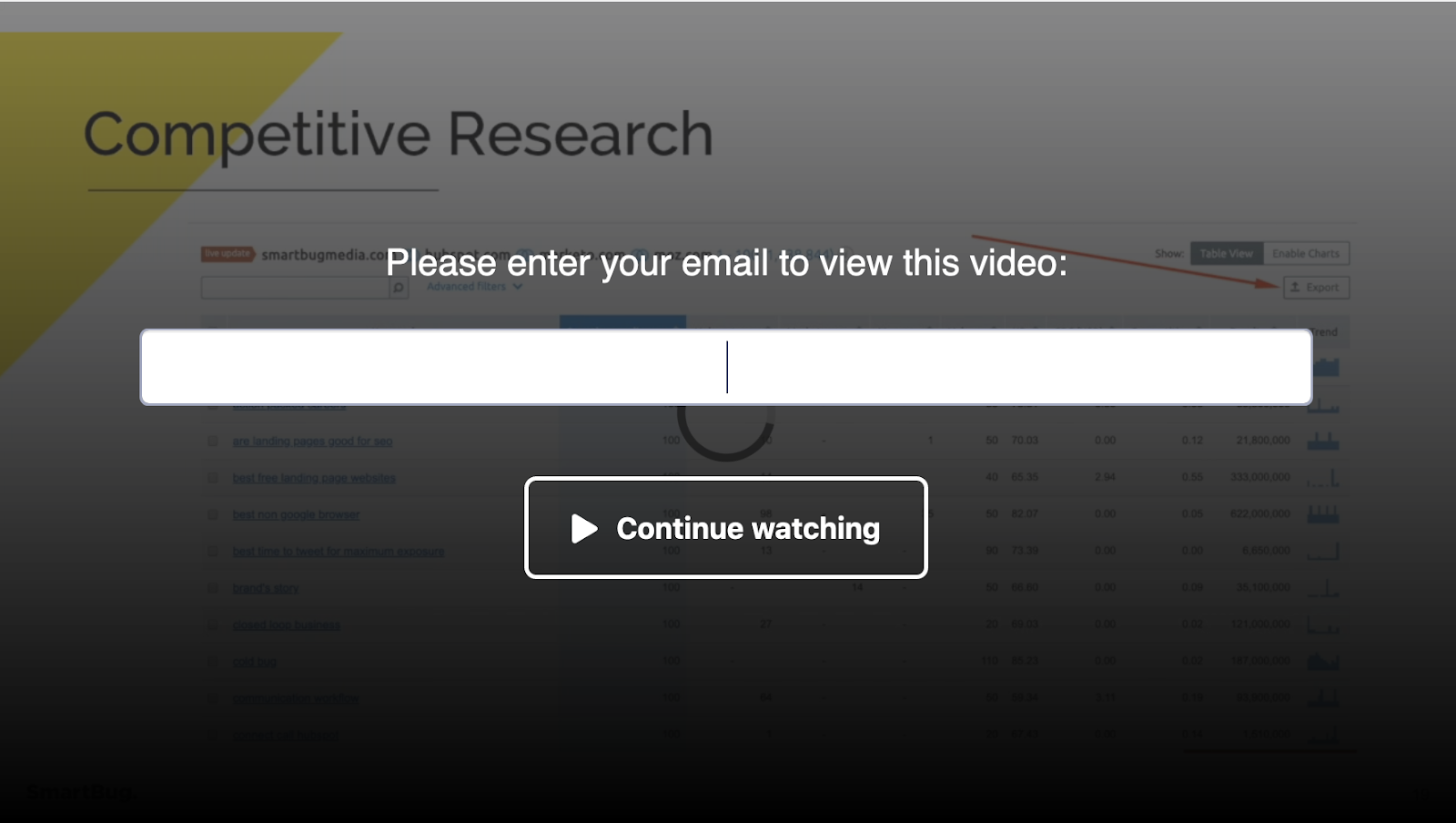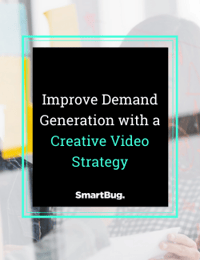
Video Marketing Best Practices
March 19, 2020
By Natalie Boyd
Video marketing is one of the strongest ways to give a visual introduction or demonstration of your products or services—and it allows you to capture the attention of your buyer personas at the right stage of the Buyer’s Journey.
Your videos can be shot simply with your phone or elaborate productions by an outside vendor. In either case, here are best practices, resources, and lead generation tips to ensure your company benefits from video marketing.
1. Determine Your Goal
To benefit from video, your marketing strategy needs to be built around goals that are SMART: specific, measurable, achievable, relevant, and time-sensitive. You can create these goals by asking the following questions:
- Specific: What do you want your videos to accomplish?
- Measurable: How will you measure the results of your efforts?
- Achievable: Is your goal attainable or not?
- Relevant: Does the goal align with your organization’s larger goals?
- Time-sensitive: When do you need to achieve the goal by?
2. Do Your Research
The best way to find inspiration is to look at other content that is performing well on the platforms you intend to use. Take the time to look at top businesses and influencers in your industry. Although you by no means want to copy what your competition is doing in video marketing, any good plan includes research. Evaluate what other content is doing, take note of what you like, and set out to do it better.
3. Make Your Videos Search-Engine Friendly
Video is a fundamental part of search results, appearing in both combined search results and video search results. In order for people to find your video online, Google must be able to extract information to understand what your video is about.
Follow these tips to improve your video search results:
- Make your videos crawlable: If Google can crawl your video, they can provide a thumbnail and other features.
- Include meta tags and titles: By providing video that is formatted for search engines, the chances of your video appearing in the search results increases.
- Use structured data or a video sitemap: Structured data helps Google understand your video better. A video sitemap helps Google find new or changed content.
Vidyard's Content Marketing Manager Kendall Walters offered up this pro tip:
"Optimizing videos for search isn’t that different from optimizing text based content. In fact, it is the copy attached to your video (in the form of metadata) and the copy surrounding it (in the form of a description or transcript) that make a difference. One of the most impactful steps you can take to optimize your videos is to add captions. This way, whatever relevant keywords you’ve discussed in the actual video will be crawlable by search engines, telling them even more about what your video’s about."
4. Use a High-Quality, Eye-Catching Thumbnail
In this visual day in age, your thumbnail image could be the deciding factor for whether or not someone clicks through to your video. A good thumbnail stands out in search results and lets your viewers know what your video is about and why they should watch it.
Vidyard suggests the following thumbnail best practices to inspire clicks:
- Declutter
- Focus on faces and emotions
- Manage color and contrast
- Try animation
- Include your branding
- Don’t use a clickbait thumbnail (but use drama when appropriate)
- Use high resolution
5. Don’t Forget a Call to Action
Calls to action are essential to any marketing endeavor, including video. Be sure to include a call to action in the video itself and the video landing page.
- Point viewers to your website for a free white paper, more information, or a discount offer.
- If you are posting a how-to video on your website, surround it with calls to action on the page that let your audience know you have the materials they need, the knowledge to do it for them, or the how-to guide to help them.
- If you are uploading to YouTube, take advantage of YouTube’s call-to-action overlays that make offers to viewers, can include more information about your business, and help drive traffic to your website.
6. Make It Social
When you post a video, make it easy for viewers to share via Facebook, LinkedIn, Twitter, Pinterest, email, and embed codes on their own blogs. This will increase your engagement and comments, a key to video success. More than 50 percent of videos on YouTube include comments from the community; make sure yours is one that people are talking about.
7. Location, Location, Location
Are your videos appearing on your website as well as on YouTube? It doesn’t matter if you embed them on a page or link to the YouTube page—get that content on your site. But don't let it get lost. Don't hide it in a blog post that will eventually get buried by newer posts. Create a landing page to showcase your excellent offerings. Leave a trail to your videos around your site with thumbnails and links promoting them.
8. Repurpose Great Content
When you have great content, look for ways you can leverage the investment. The videos you’ve created can be used to create other valuable marketing materials:
- Create a text transcript for all videos. Text transcripts of videos benefit your website by contributing content for search engine optimization. They also can provide compliance where necessary. Transcripts easily provide quotes for use in press releases and other marketing materials.
- Use the video’s audio to create a podcast for distribution on Apple Podcasts and other podcast platforms. This will help increase distribution numbers and reach audiences.
- Create still images from the videos to post on Pinterest, Facebook, Instagram, and other profiles, and link back to your video or website.
Video Marketing Resources You Should Subscribe To
Before you go out and buy thousands of dollars of video equipment, gather some valuable information. Or even better, get that information sent directly to your inbox!
After scouring the internet, we found 10.5 top video marketing resources you should subscribe to today.
1. Tubular Insights
Tubular Insights is your go-to resource for news, analysis, and tips for video marketing. This website has information on video marketing, video SEO, social videos, different video platforms, and even video pertaining to specific industries. Each month, it posts a leaderboard of top videos and publishers on Facebook and YouTube. By subscribing, you are signing up for daily video tips and insights.
2. Vidyard
Vidyard is a video platform that helps businesses transform communications and drive more revenue through the strategic use of online video. It also has some killer blog content. By subscribing to Vidyard’s blog, you will get articles pertaining to demand generation, marketing communications, small business marketing, and video production. Each article from Vidyard takes a look at video marketing and how it can fit into all aspects of your marketing strategy.
3. Video Brewery
Video Brewery is a great resource for finding freelancers to create custom videos for your business, and it is also an excellent source for video marketing education. The Video Brewery blog focuses on different types of video marketing content and gives awesome examples of video done well.
4. Wistia
Wistia is a professional video hosting platform with analytics and video marketing tools (it also has HubSpot integration). Wistia’s blog covers just about everything you could want to learn when it comes to video. The two major topics it covers are video production and using video.
5. Engage Video Marketing
Engage Video Marketing is a podcast leading the discussion about video engagement and moving people to action. Listen to episodes about how to get views on your videos, video marketing trends, and how to get started in video marketing. So, turn off the radio, and turn on one of these episodes.
6. Magnet Media
Magnet Media is a video production, optimization, and strategy agency. Magnet Media’s blog is a combination of written copy and actual video. The blog provides occasional information on content marketing as a whole. Magnet Media is a great resource for learning more about storytelling in general.
7. SproutVideo
SproutVideo is another video hosting platform. SproutVideo’s blog provides the essentials of video creation and marketing, along with awesome video examples. Subscribing signs you up for a weekly update, so your inbox won’t feel the pain.
8. Shakr
Shakr is a DIY video creation software. You have to subscribe to the blog via RSS, but it’s worth it. You’ll learn more about using videos on all of the different social media platforms available.
9. Vimeo
If you are looking for a resource to spark your creativity, Vimeo is for you. Vimeo’s Video School is a great way to learn production techniques for video creation.
10. Think with Google
Like Vimeo, YouTube/Google keeps track of its top-performing video content. By subscribing to Think with Google, you can learn about different video techniques that have been successful on YouTube, and keep up with the leaderboards from Cannes and YouTube Ads.
Bonus: SmartBug®
We couldn’t recommend great video marketing resources without mentioning a great marketing resource in general. Subscribe below to the SmartBug blog and get actionable insights about inbound marketing, web design, content marketing, and public relations, as well as information related to video marketing.
Using Videos for Lead Generation
Video marketing has been a staple of lead generation for quite some time. Some examples of this are: live video, virtual reality, and 3D. Make sure that you’re using video to its fullest potential and your content helps move your prospects through the marketing funnel.
Here are some tips on how to turn your videos into lead generation magic:
1. Use Gates and CTAs in Your Videos
In a parking garage or apartment complex, you have to plug in a code or pull a ticket to get that gate to lift up or door to open and let you in. Your video marketing should employ the same concept. The simplest way to capture prospects’ contact information is to set up a gate on your video.
Traditionally, inbound marketers would create a landing page requiring an email address or some other type of information in order to share the video content with a redirect link. This method is not always ideal due to long page load times and more work for the user, not to mention that the landing page is open to sharing and isn’t private.
To address this, tools like Vidyard and Wistia have created ways for marketers to display a simple form in the video player, ensuring you grab that lead’s information before the video plays.

Example of Vidyard’s video player email gate
Keep in mind that this kind of gate is best suited for mid-funnel video content. Think of your content trail leading a prospect to your product demo video. All the content that brings them to that demo video is ungated, but the demo video is gated, allowing you to see how many leads will volunteer more information to get that particular video. If you have already offered them a lot of quality top-of-the-funnel content, you will get some high-quality leads.
CTAs are another great addition to your video marketing strategy within your marketing funnel.
YouTube Annotations and other pop-out CTAs are great additions to make sure your viewers are engaging with your content and moving down the marketing path they want to take. You want your viewers to take action, and including these elements during a video is a great way to engage them in the moment—for example, you could have an annotation text link pop up right at that moment when you are discussing a particular service or product. This is a great way to link people to other content you want them to view.
2. Create a Live Video Series
One-off videos are well and good, but we are in the go-live era. A live video marketing strategy is most successful when it uses a regularly scheduled series that provides value and keeps viewers coming back.
The best way to approach putting a series like this together is to start with your SMART goals. An example of a SMART goal for a live video series would be to produce a five-episode biweekly series that gets an average monthly viewership of 200 and engagement of 75 over the next 3-6 months.
3. Repurpose Your Live Video Content
It’s one thing to take a chance and produce a cool live video series or a live webinar through Facebook, but some of your buyer personas might live on a different social platform or channel. If cable providers can give us on-demand video, then surely you can do the same with your content.
If you only went live on Facebook, upload your video to Twitter, YouTube, LinkedIn, Vimeo, and other social networks that accept long-form video. This helps keep all of your accounts active and increases the odds of your content being discovered.
Referencing the subject matter of a live video in a later blog post is another great approach. You can do this in a couple of different ways, such as taking the Q&A from a live video and turning it into a series of social media posts, transcribing your video into a blog article, and even turning that video into a podcast episode by creating an audio file and sharing it on your blog.
A few other repurposing ideas come straight outta Hollywood: use smaller clips, take meaningful clips from the live event and edit them down to smaller clips for sales enablement, and use special articles and other references in your content marketing strategy.
4. Create Meaningful Video for Sales Teams
Sales gets left out of the video marketing experience these days, and that shouldn’t be the case. Sales teams now have the ability to leverage video in fun and powerful ways. Video voicemails, one-off demo videos, and personalized proposals are great ways to integrate video marketing into the sales process.
Video voicemails are probably the most notable in this list because they have been trending upward recently. One-off demo videos are ways for you to answer a question or highlight a specific product feature without having to coordinate a demo meeting, while engaging with leads in a personalized, helpful way. The quick handoff videos are something that we rarely see but are extremely effective.
In a complex sales cycle, there might be a need to hand off a lead from an inside sales representative to a blue-chip closer. A way of doing this is by introducing the closer and saying goodbye through a nice video. This is a personalized experience for a lead who could feel like they’re being passed around when they read about a handoff in an email. Tie this in with the CTA idea mentioned earlier to give the lead an opportunity to schedule time on your calendar.
Videos are a lot of fun, and there is no real limit to how they can be used in your marketing strategy, especially to generate leads. All you need is some creativity and a willingness to think outside the box.
Ready to Launch Your Video Marketing Strategy?
Video marketing can be a key component within your inbound marketing strategy. Want to get started with video marketing but aren't sure how? SmartBug Media® is ready to help you from campaign concepts to execution. Contact us today to learn how video marketing can work for your company.
This post was originally published in September 2013 and has been updated.

About the author
Natalie Boyd was formerly a Marketing Specialist at SmartBug Media with 10 years of experience supporting in-house, freelance, and agency clients. She is passionate about using inbound marketing to help businesses succeed and make meaningful connections with their target audience. Read more articles by Natalie Boyd.










